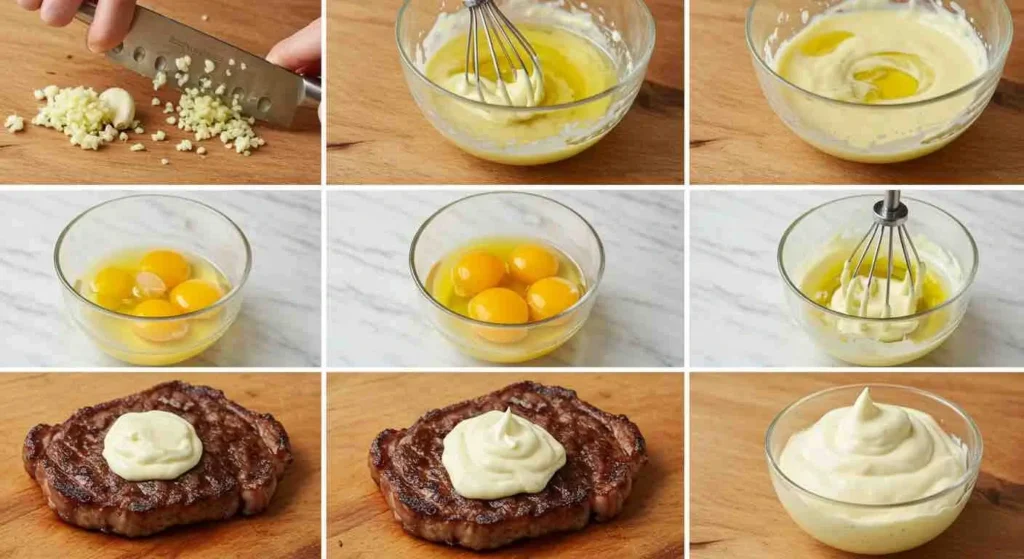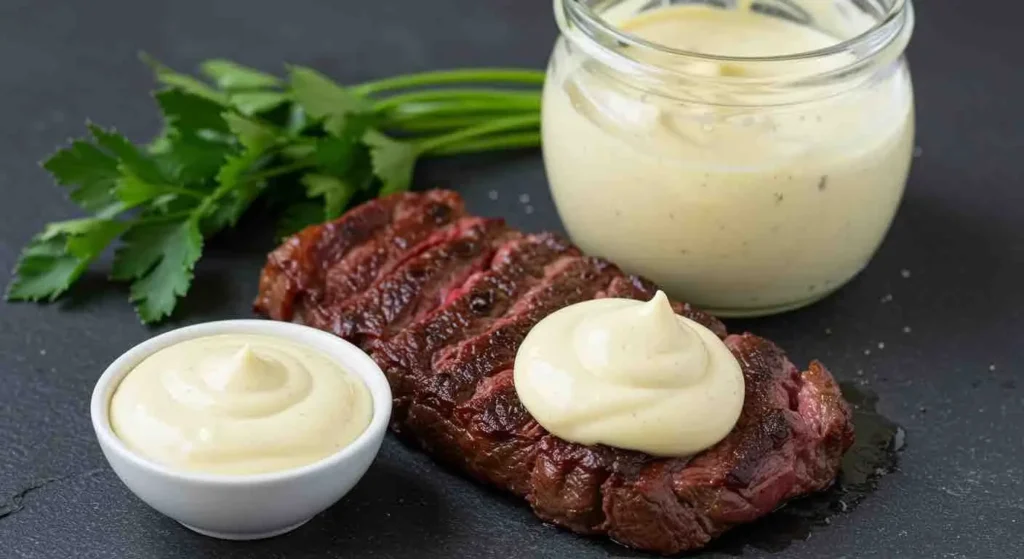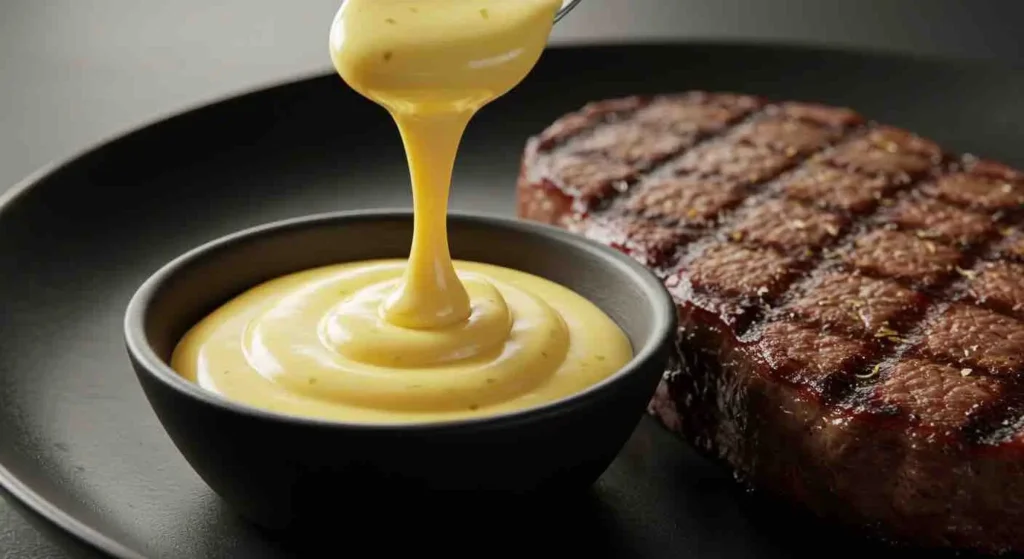introduction
When it comes to elevating a classic steak dinner, few accompaniments can match the rich, creamy allure of aioli sauce. Originating from the Mediterranean, aioli—a harmonious blend of garlic and olive oil has found its way into kitchens worldwide, becoming a beloved condiment for various dishes. When paired with steak, aioli introduces a velvety texture and a burst of flavor that complements the meat’s savory depth. Whether you’re aiming to impress guests or simply indulge in a gourmet experience at home, drizzling or dolloping aioli over a perfectly cooked steak can transform an ordinary meal into a culinary delight.
I love cooking at home and exploring new flavors Aioli Sauce for Steak, with its creamy and rich taste, is a favorite of mine. It turns a simple steak into a dish fit for a restaurant. Whether it’s a juicy ribeye or a tender filet mignon, the right aioli makes all the difference.
In this guide, I’ll share the secrets to making the best aioli for your steak. You’ll learn about aioli’s origins and how to make it. By the end, you’ll know how to create an aioli that will make your steak unforgettable.
Table of Contents
Understanding Aioli: More Than Just Garlic Mayonnaise
Aioli is a tasty and flexible sauce from the Mediterranean, especially from Provence, France, and Catalonia, Spain. It was originally made by mixing fresh garlic with olive oil in a mortar and pestle. Now, it often includes egg yolks for a creamier texture, turning it into a delicious spread.
The French and Spanish Origins
Aioli is famous in Eastern Spain and Southern France. It’s a key part of their cooking traditions. In its pure form, it’s just garlic and olive oil, blended to make a thick, tasty sauce.
Traditional vs Modern Aioli
The old way to make aioli is with garlic and olive oil. But today, people add egg yolks for a creamier texture. This makes the sauce richer and easier to mix, perfect for many dishes.
Why Aioli Elevates Your Steak
Aioli’s bold garlic taste and smooth feel make it great with steak. Its rich, garlicky flavor pairs well with the meat’s savory taste. Together, they make a meal that’s truly special.
“Aioli is a game-changer for steak, adding a depth of flavor that can’t be matched by traditional condiments.”

Essential Ingredients for Perfect Aioli Sauce for Steak
Making the perfect aioli sauce for your steak is all about the right ingredients. This creamy dip adds a special touch to your steak, making every bite better. Let’s look at what makes a great aioli sauce.
At the core of aioli are eggs. Using room-temperature eggs is key for a smooth texture. The egg yolks mix everything, creating a perfect blend.
Choosing the right oils is crucial. Extra-virgin olive oil gives a strong flavor, while sunflower or safflower oil adds a milder taste. Together, they make a creamy sauce.
No aioli is complete without garlic. You can use fresh or roasted garlic, depending on what you like. Adjust the garlic to your taste.
A bit of lemon juice or vinegar adds a tangy touch. This balances out the richness of the sauce. A pinch of salt finishes it off, making the flavors just right.
With these ingredients, you can make a delicious aioli sauce. It will take your steak to a whole new level. Impress your guests with this tasty, creamy dip!
| Ingredient | Quantity | Purpose |
|---|---|---|
| Eggs (room temperature) | 1-2 yolks | Emulsification and binding |
| Olive oil | 1/2 to 1 cup | Flavor and texture |
| Garlic (raw or roasted) | 1-3 cloves | Signature flavor |
| Lemon juice or vinegar | 1-2 tablespoons | Acidity and tang |
| Salt | 1/4 to 1/2 teaspoon | Seasoning and balance |
The Science Behind Emulsion in Aioli Making
Aioli is more than just a simple mayonnaise. It’s an emulsion, a mix of oil, egg yolks, and seasonings. Knowing the science behind it can help you make the perfect aioli for your steak.
Temperature Considerations
Temperature is key for a good aioli emulsion. Eggs work better at room temperature. This is because their proteins are more flexible and can hold oil droplets better at warmer temperatures. Let your eggs sit at room temperature before making aioli.
Oil Selection and Ratios
The type and ratio of oils used in aioli matter a lot. A mix of olive oil and a neutral oil like grapeseed or canola is best. Olive oil gives aioli its flavor, while neutral oil makes it smoother. Aim for a 50/50 or 60/40 ratio of neutral oil.
When adding oil, do it slowly, drop by drop, at the start. This helps the egg yolks bind with the oil, making a thick, creamy aioli emulsion. Adding oil too fast can break the emulsion, making the sauce thin and separated.
| Ingredient | Quantity |
|---|---|
| Eggs (room temperature) | 2 egg yolks |
| Olive Oil | 1/2 cup |
| Grapeseed Oil | 1/2 cup |
| Garlic (minced) | 2 cloves |
| Lemon Juice | 1 tbsp |
| Salt | to taste |
By understanding aioli emulsion science, you can make perfect homemade aioli. It will enhance your steak and elevate your meal.
Classic vs Shortcut Methods of Aioli Preparation
When making homemade aioli for your steak, you have two main choices: the classic method and the shortcut method. Both can make delicious aioli, but each has its benefits.
The classic method uses raw eggs, oil, and garlic to make the sauce from scratch. This traditional way gives a true taste and texture, just like the classic Spanish and French aioli. But, it takes more time and effort to get it right.
The shortcut method starts with mayonnaise, adding garlic and lemon juice for a quick aioli recipe. This method is quicker but loses some of the classic flavors. Still, it’s a good choice for those who want to save time without losing too much taste. The aioli sauce for steak made this way can still make your meal better.
“The classic method offers a more authentic taste and texture, but the shortcut method is a great time-saver without sacrificing too much flavor.”
Choosing between the classic and shortcut methods depends on your preferences, available time, and how authentic you want your aioli sauce for steak to be. Both methods can make tasty aioli, so try them out and see which one works best for you.
Step-by-Step Guide to Traditional Aioli
Making the perfect aioli recipe at home is a skill that brings a rich, creamy sauce to your table. It’s great as a dip for steak or to enhance your favorite dishes. Let’s explore how to make a homemade aioli that will delight your taste buds.
Equipment Needed
- Food processor or high-powered blender
- Sturdy whisk (optional)
- Measuring cups and spoons
- Airtight container for storage
Mixing Techniques
Start by mixing the garlic aioli ingredients in your food processor or blender: garlic, lemon juice, and egg yolks. Blend until it’s light and frothy. Then, slowly add the oil while blending, creating a creamy texture.
Troubleshooting Tips
If your aioli recipe looks separated or too thin, it’s okay! You can fix it. Add a little warm water, about 1/2 teaspoon at a time, and blend until it’s right. Or, add another egg yolk to help it come together.
With the right tools, technique, and patience, you’ll make perfect homemade aioli. It will make your steak and other dishes even better. Enjoy making it and relish the tasty outcome!

Quick and Easy 10-Minute Aioli Recipe
Elevating your steak has never been easier with this quick and easy 10-minute aioli recipe. Forget the lengthy traditional method – this shortcut version delivers the same delicious garlic-infused flavor profile in a fraction of the time.
To make this quick aioli, simply combine 1 cup of mayonnaise with 2-3 finely grated garlic cloves, a pinch of salt, and 1-2 teaspoons of fresh lemon juice. Whisk the ingredients together until well-blended, then adjust the seasoning to your taste. That’s it – your easy aioli recipe is ready to serve as the perfect steak topping.
The best part? This aioli can be made in less than 10 minutes, making it a convenient and hassle-free addition to your steak night. With just 5 simple ingredients, you’ll have a creamy, flavorful sauce that rivals the traditional method.
| Ingredient | Amount |
|---|---|
| Mayonnaise | 1 cup |
| Garlic, finely grated | 2-3 cloves |
| Salt | Pinch |
| Lemon juice | 1-2 tsp |
For a richer, more complex flavor, try adding a touch of Dijon mustard or a sprinkle of cayenne pepper. The possibilities are endless when it comes to customizing your quick aioli to perfectly complement your steak.
“This 10-minute aioli recipe is a game-changer for busy weeknights. It’s so quick and easy, yet tastes just like the real thing.”
So, next time you’re craving a steakhouse-quality meal at home, reach for this simple easy aioli recipe. With its bold garlic flavor and creamy texture, it’s sure to elevate your steak to new heights.
Best Garlic Options for Your Aioli
Choosing the right garlic is key to making great garlic aioli. Raw garlic gives a strong, pungent taste. Roasted garlic, on the other hand, is sweeter and milder. Both can make your aioli stand out, depending on what you like.
Raw vs Roasted Garlic
For a bold garlic flavor, use raw garlic. Grate or mince it finely before mixing it into your aioli. This way, the garlic’s full flavor comes through, making your sauce vibrant and strong.
Roasted garlic, however, adds a softer, sweeter taste. Roast the cloves in the oven until they’re soft and golden. Then, mash or puree them before adding to your aioli. This method makes the garlic milder and more balanced, creating a smooth garlic aioli.
Garlic Infusion Methods
Want a garlicky sauce without actual garlic bits? Try infusing the aioli with garlic flavor. Mince the garlic and let it soak in lemon juice for 10 minutes. Then, strain the lemon juice and add it to your roasted garlic spread or garlicky sauce.
Try different garlic types, like elephant garlic or heirloom varieties, to find the perfect flavor for your garlic aioli.
Storage and Shelf Life Tips
Keeping your homemade aioli fresh and flavorful is key. To keep your garlic spread tasty and safe, follow these tips:
Homemade aioli can be stored in a sealed container in the fridge for up to 10 days. As it cools, it will thicken, becoming creamy and spreadable. Freezing aioli is not recommended, as it can ruin the texture.
Always use clean tools when serving aioli to keep it fresh longer. Good storage and hygiene are crucial for maintaining its taste and quality.
Tips for Maximizing Aioli Shelf Life
- Store aioli in an airtight container in the refrigerator for up to 10 days.
- Avoid freezing aioli, as this can disrupt the emulsion and change the texture.
- Use clean utensils when serving to prevent contamination and extend the shelf life.
- Keep aioli chilled and away from direct heat or sunlight to maintain its freshness.
By following these easy tips, you can enjoy your homemade aioli at its peak. Savor the creamy garlic taste for days.
Flavor Variations and Additional Ingredients
Take your steak to the next level with flavored aioli sauces. You can try many herbs, spices, and citrus to make unique flavors. This way, you can enjoy a new taste every time.
Herbs and Spices
Add fresh herbs like basil, tarragon, or chives to your aioli. For a smoky flavor, mix in smoked paprika or cayenne pepper. These changes make your aioli a great match for your steak.
Citrus Options
Give your aioli a zesty kick by using lime or orange juice instead of lemon. Adding citrus zest brings out more aroma and tanginess. These bright flavors balance the steak’s richness, making each bite exciting.
Try different flavors to find the perfect aioli for your steak. The world of aioli is vast, so explore and find your favorite combination.

Perfect Steak Pairings for Different Aioli Styles
Choosing the right aioli sauce can elevate your steak experience. The best aioli style depends on the steak’s cut and flavor. This ensures a perfect and gourmet pairing.
For classic ribeye or sirloin steaks, garlic aioli is a great choice. Its creamy, umami-rich flavor complements the beefiness of these cuts. Leaner cuts like filet mignon, however, pair well with herb-infused aioli. This adds delicate herbal notes that balance the meat’s tenderness.
Steaks with bold flavors, like skirt or flank steak, benefit from spicy aioli. Ingredients like sriracha, smoked paprika, or chipotle add heat and complexity. This enhances the steak’s natural flavors, making for a dynamic and gourmet topping. The key is to match the aioli style with the steak for a delightful dining experience.
Conclusion
Pairing a perfectly cooked steak with a rich, flavorful aioli sauce creates a dining experience that tantalizes the taste buds. The creamy, garlicky essence of aioli enhances the natural succulence of the steak, offering a delightful fusion of textures and flavors. Whether drizzled over a seared filet mignon or served alongside steak frites, aioli introduces a gourmet touch that elevates the entire meal. Exploring various aioli variations, such as roasted garlic or truffle-infused, allows for personalization and creativity in the kitchen. Embracing this combination not only enriches your culinary repertoire but also promises to impress on any dining occasion.
FAQ
What is aioli and how does it elevate steak?
Aioli is a creamy garlic sauce that makes a simple steak taste like a restaurant dish. It’s made with raw garlic, olive oil, and sometimes egg. This gives a rich, garlicky flavor that goes well with the meat’s savory taste.
What are the origins of aioli?
Aioli comes from the Mediterranean coastal cuisines of Provence, France, and Catalonia, Spain. The traditional version is just garlic and olive oil mixed in a mortar and pestle. Modern aioli often includes eggs for a creamier texture.
What are the key ingredients for making aioli?
The main ingredients for aioli are eggs (at room temperature), extra-virgin olive oil, and a neutral oil like sunflower or safflower. You also need raw or roasted garlic, lemon juice or vinegar, and salt. Using high-quality ingredients is key for the best flavor.
What is the science behind creating a stable aioli emulsion?
Aioli is an emulsion of oil and egg yolks. The eggs’ temperature is important for proper emulsification. Add the oil slowly, drop by drop at first, to create a stable emulsion. The ratio of oil to other ingredients also affects the consistency.
What are the differences between the classic and shortcut methods of making aioli?
The classic method uses raw eggs, oil, and garlic to make aioli from scratch. The shortcut method uses mayonnaise as a base and adds garlic and lemon juice for flavor. Both methods can make delicious aioli, but the classic method offers a more authentic taste and texture.
How do I make traditional homemade aioli?
To make traditional aioli, use a food processor or blender. Blend garlic, lemon juice, and eggs until frothy. Then, slowly add oil while blending to create an emulsion. If it separates, try adding a small amount of warm water or an extra egg yolk to help it come together.
What’s the quickest way to make aioli?
For a quick aioli, mix 1 cup mayonnaise with 2-3 finely grated garlic cloves, a pinch of salt, and 1-2 teaspoons of lemon juice. Adjust the seasoning to your taste. This method gives a similar flavor to traditional aioli but in less time.
What are the differences between raw and roasted garlic in aioli?
Raw garlic has a strong, pungent flavor, while roasted garlic is milder and sweeter. For raw garlic, finely grate or mince the cloves before adding them to the aioli. To infuse garlic flavor without bits of garlic, soak minced garlic in lemon juice for 10 minutes, then strain before mixing with the other ingredients.
How long can homemade aioli be stored, and can it be frozen?
Homemade aioli can be stored in an airtight container in the refrigerator for up to 10 days. It will thicken as it chills. Avoid freezing aioli as it can break the emulsion and change the texture. Always use clean utensils when serving to prevent contamination and extend the shelf life.
How can I experiment with different flavors in my aioli?
You can try adding various herbs and spices to create unique aioli flavors. Fresh herbs like basil, tarragon, or chives work well. Spices such as smoked paprika or cayenne can add depth. For citrus variations, substitute lime or orange juice for lemon, or add zest for extra flavor.
What are the best steak pairings for different aioli styles?
Classic garlic aioli pairs well with ribeye or sirloin steaks. Herb-infused aioli complements leaner cuts like filet mignon. Spicy aioli variations work well with flavorful cuts like skirt or flank steak. Choose an aioli style that matches the steak’s flavor for a harmonious pairing.


Comments are closed.